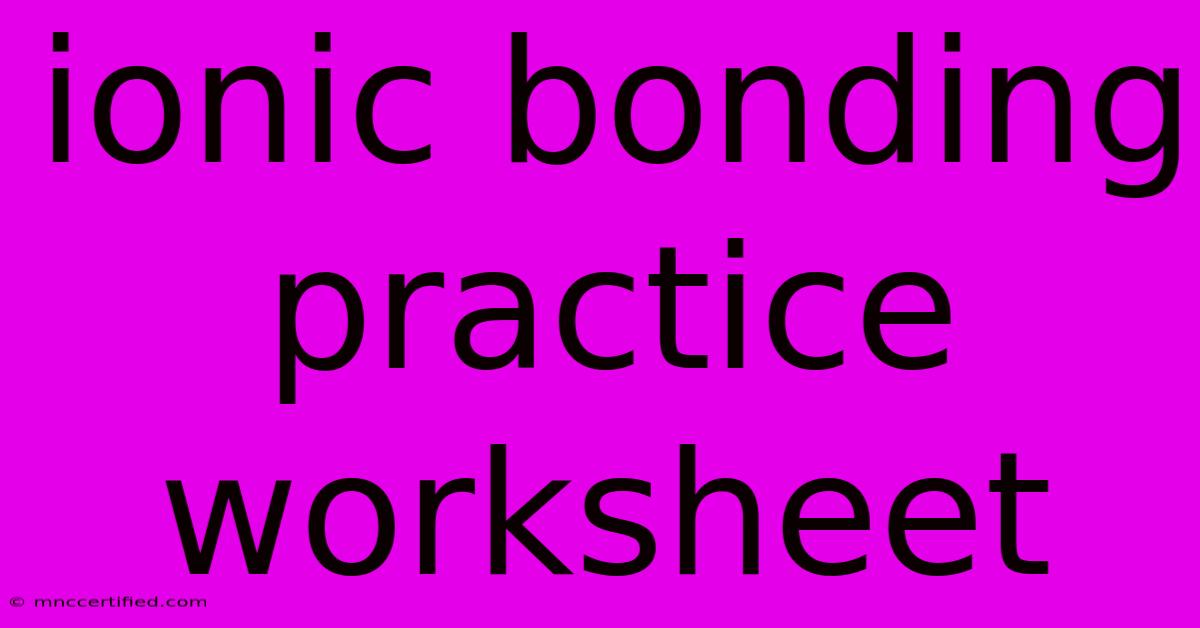Ionic Bonding Practice Worksheet

Table of Contents
Ionic Bonding Practice Worksheet: Master the Basics with These Exercises
Are you struggling to grasp the concepts of ionic bonding? Do you need extra practice to solidify your understanding before the next big exam? This comprehensive guide provides a detailed explanation of ionic bonding, followed by a practice worksheet with answers to help you master this crucial chemistry topic.
Understanding Ionic Bonding: A Quick Recap
Ionic bonding is a type of chemical bonding that involves the electrostatic attraction between oppositely charged ions. These ions are formed when atoms transfer electrons to achieve a stable electron configuration, typically resembling a noble gas. This transfer results in one atom becoming a positively charged cation (by losing electrons) and another becoming a negatively charged anion (by gaining electrons).
Key characteristics of ionic bonding:
- Electrostatic attraction: The strong force of attraction between positive and negative ions holds the compound together.
- Electron transfer: Electrons are completely transferred from one atom to another, not shared as in covalent bonding.
- High melting and boiling points: The strong electrostatic forces require significant energy to overcome.
- Crystalline structure: Ionic compounds typically form a regular, repeating crystal lattice structure.
- Conductivity: Ionic compounds conduct electricity when molten (liquid) or dissolved in water, as the ions are free to move.
Identifying Ions: A crucial step
Before tackling ionic bonding, you need to confidently predict the charge of ions formed by different elements. This typically involves looking at the element's position on the periodic table and determining how many electrons it needs to gain or lose to achieve a full outer electron shell (octet rule). For example:
- Group 1 (alkali metals): Lose 1 electron to form a +1 ion (e.g., Na⁺)
- Group 2 (alkaline earth metals): Lose 2 electrons to form a +2 ion (e.g., Mg²⁺)
- Group 17 (halogens): Gain 1 electron to form a -1 ion (e.g., Cl⁻)
- Group 16 (chalcogens): Gain 2 electrons to form a -2 ion (e.g., O²⁻)
Ionic Bonding Practice Worksheet
Now, let's put your knowledge to the test! The following worksheet includes exercises designed to reinforce your understanding of ionic bonding.
Part 1: Predicting Ionic Charges
- What is the charge of the ion formed by potassium (K)?
- What is the charge of the ion formed by oxygen (O)?
- What is the charge of the ion formed by magnesium (Mg)?
- What is the charge of the ion formed by chlorine (Cl)?
- What is the charge of the ion formed by aluminum (Al)?
Part 2: Writing Ionic Formulas
Write the chemical formula for the ionic compound formed by the following pairs of elements:
- Sodium (Na) and chlorine (Cl)
- Calcium (Ca) and oxygen (O)
- Magnesium (Mg) and bromine (Br)
- Aluminum (Al) and sulfur (S)
- Potassium (K) and nitrogen (N)
Part 3: Naming Ionic Compounds
Name the following ionic compounds:
- NaCl
- MgO
- KBr
- Al₂O₃
- CaCl₂
Part 4: Advanced Practice (Optional)
- Explain why ionic compounds are generally brittle.
- Describe the difference between ionic and covalent bonding.
- Predict the formula for the ionic compound formed between iron(III) and oxygen.
Answers to the Ionic Bonding Practice Worksheet
Part 1: Predicting Ionic Charges
- +1
- -2
- +2
- -1
- +3
Part 2: Writing Ionic Formulas
- NaCl
- CaO
- MgBr₂
- Al₂S₃
- K₃N
Part 3: Naming Ionic Compounds
- Sodium chloride
- Magnesium oxide
- Potassium bromide
- Aluminum oxide
- Calcium chloride
Part 4: Advanced Practice (Optional) (Answers will vary slightly depending on the level of detail provided)
- Ionic compounds are brittle because the strong electrostatic forces between ions hold them in a rigid lattice. A slight shift in the lattice can cause like charges to align, leading to repulsion and fracture.
- Ionic bonding involves the complete transfer of electrons, resulting in oppositely charged ions held together by electrostatic attraction. Covalent bonding involves the sharing of electrons between atoms.
- Fe₂O₃
This worksheet provides a solid foundation for understanding ionic bonding. Remember to consult your textbook and teacher for additional support if needed. Good luck with your studies! Remember to use this article as a resource and practice regularly to master this important concept. Don't hesitate to search for additional practice problems online for further reinforcement.

Thank you for visiting our website wich cover about Ionic Bonding Practice Worksheet. We hope the information provided has been useful to you. Feel free to contact us if you have any questions or need further assistance. See you next time and dont miss to bookmark.
Featured Posts
-
Oats Alabama Freshman Climbing Draft Boards
Nov 20, 2024
-
Investment Banking Jobs Hong Kong
Nov 20, 2024
-
Who Is Linda Mc Mahon Wwe And Politics
Nov 20, 2024
-
Trump Names Linda Mc Mahon Sba Head
Nov 20, 2024
-
Producer Prices Down 0 8 In Uk October
Nov 20, 2024